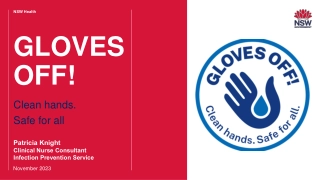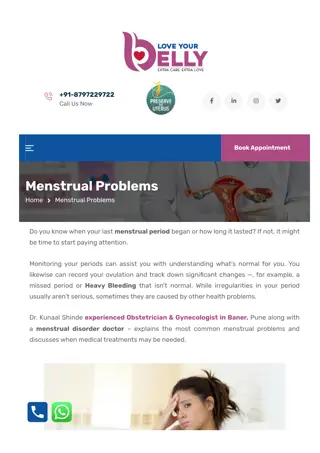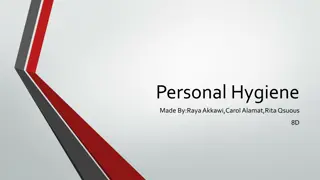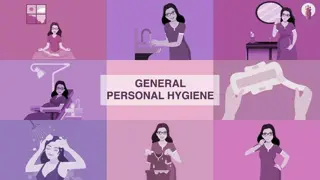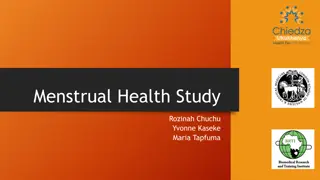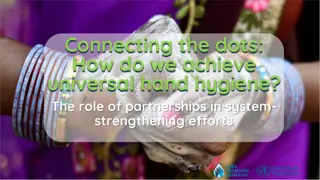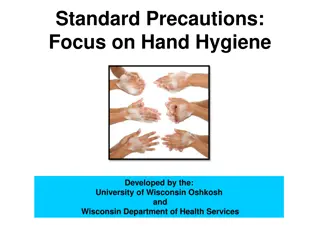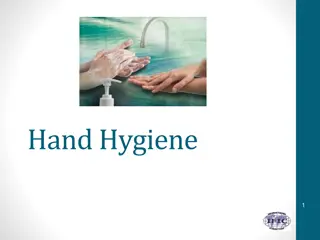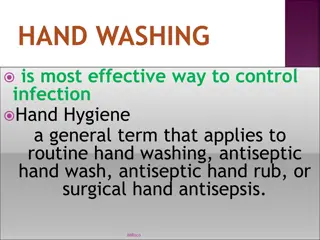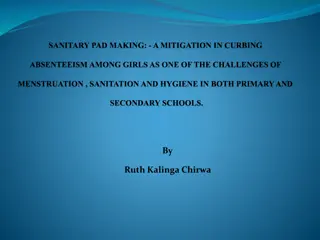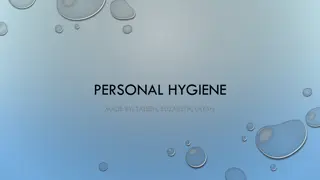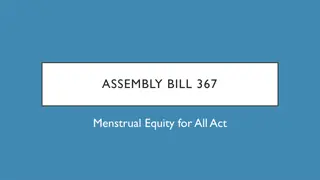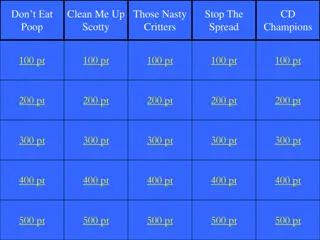
Menstrual Hygiene and Health Education for Girls
Explore the importance of menstrual hygiene management (MHM) and Menstrual Health and Hygiene (MHH) in promoting health, well-being, and gender equality. Learn about the principles, tips, and awareness surrounding menstrual hygiene to ensure a safe and comfortable experience. Discover the role of MHM in the Sustainable Development Goals (SDGs) and the key factors that contribute to a comprehensive MHH approach.
Uploaded on | 1 Views
Download Presentation

Please find below an Image/Link to download the presentation.
The content on the website is provided AS IS for your information and personal use only. It may not be sold, licensed, or shared on other websites without obtaining consent from the author. If you encounter any issues during the download, it is possible that the publisher has removed the file from their server.
You are allowed to download the files provided on this website for personal or commercial use, subject to the condition that they are used lawfully. All files are the property of their respective owners.
The content on the website is provided AS IS for your information and personal use only. It may not be sold, licensed, or shared on other websites without obtaining consent from the author.
E N D
Presentation Transcript
StudyMafia.Org Menstrual Hygiene Submitted To: Studymafia.org Studymafia.org Submitted By:
Table Contents Definition Introduction Menstrual Hygiene in SDGs Menstrual Hygiene Principles Tips for Menstrual Hygiene Menstrual Hygiene Awareness Conclusion 2
Definition Menstrual hygiene, a very important risk factor for reproductive tract infections, is a vital aspect of health education for adolescent girls. 3
Introduction Menstrual hygiene management (MHM) refers to management of hygiene associated with the menstrual process. WHO and UNICEF Joint Monitoring Progrramme (JMP) for drinking water, sanitation, and hygiene has used the following definition of MHM: Women and adolescent girls are using a clean menstrual management material to absorb or collect menstrual blood, that can be changed in privacy as often as necessary for the duration of a menstrual period . 4
Introduction Menstrual health and hygiene (MHH) encompasses both MHM and the broader systemic factors that link menstruation with health, well-being, gender equality, education, equity, empowerment, and rights. These systematic factors have been summarized by UNESCO as accurate and timely knowledge, available, safe, and affordable materials, informed and comfortable professionals, referral and access to health services, sanitation and washing facilities, positive social norms, safe and hygienic disposal and advocacy and policy 5
Menstrual Hygiene Principles Gender-equal MHH progrrammes reinforce equality between girls and boys. Women and girls are given opportunities to lead MHH progrrammes through participatory approaches to design, implementation and monitoring. UNICEF WASH staff and partners implement progrrammes using gender expertise 8
Menstrual Hygiene Principles Government-Led Technical working groups are led by ministries responsible for education or health, and oversee programme design and implementation. MHH programmes align with national strategies and plans in WASH, education, gender, women, youth, health and other relevant sectors 9
Menstrual Hygiene Principles Evidence-based Interventions are designed based on a needs assessment; formative research is widely disseminated. Robust monitoring, evaluation, and operational research build the global evidence base on MHH programmes 10
Menstrual Hygiene Principles Capacity-building Programmes develop technical capacity within UNICEF staff, governments, partners, community members, girls, boys, women and men. Capacity building focuses on appropriate skills and knowledge to talk openly about puberty, menstruation, and girls empowerment 11
Menstrual Hygiene Principles Inclusive Programmes make special efforts to reach and co-design with girls with disabilities, girls from minority groups, transgender or non-binary menstruators. Programmes engage men and boys. 12
Absorbents Used Reusable and Washable Cloth Pads They may be sustainable sanitary option but must be hygienically washed and dried in the sunlight. Commercial Sanitary Pads They are easily available at many stores, chemist shops, or online. They are expensive, compared to cloth pads, nonreusable, and not very environment-friendly. 13
Absorbents Used Tampons They are the type of absorbent that provides internal protection. They are kind of plug of soft material (cotton) which is inserted into the vagina to absorb the menstrual flow before it leaves the body. Reusable Tampons These are washable tampons made up of natural materials like bamboo, wool, cotton, or hemp. 14
Absorbents Used Menstrual Cups They may be a new technology for poor women and girls and an alternative to sanitary pads and tampons. They are like cups made of medical grade silicone rubber which makes the cup easy to fold and get inserted into the vagina to collect menstrual blood. Bamboo Fibre Pads Instead of wood pulp, bamboo pulp is used as an absorbing material in these sanitary pads. 15
Absorbents Used Menstrual Cups They may be a new technology for poor women and girls and an alternative to sanitary pads and tampons. They are like cups made of medical grade silicone rubber which makes the cup easy to fold and get inserted into the vagina to collect menstrual blood. Bamboo Fibre Pads Instead of wood pulp, bamboo pulp is used as an absorbing material in these sanitary pads. 16
Tips for Menstrual Hygiene 1. Choose your method of sanitation: 2. Change regularly 3. Wash yourself regularly 4. Don t use soaps or vaginal hygiene products 5. Use the right washing technique 6. Discard your used sanitary product properly 7. Beware of a pad rash 8. Use only one method of sanitation at a time 9. Have a bath regularly 10. Be ready with on-the-go stuff during your periods 17
Menstrual Hygiene Awareness While Menstrual Hygiene Day is on 28 May, our team and our partners work all year round to: Break the taboos and end the stigma surrounding menstruation. Raise awareness about the challenges regarding access to menstrual products, education about menstruation and period-friendly sanitation facilities Mobilise the funding required for action at scale 20
Conclusion Menstrual hygiene should be promoted by implementing a course on menstruation and menstrual hygiene management. Teachers should be educated and trained to impart knowledge about menstruation and menstrual hygiene management among students. Social and electronic media also play an important role to make the girls and women aware about the latest menstrual products, different manufacturers, government policies, and so forth. 21
References Google.com Wikipedia.org Studymafia.org Slidespanda.com
Thanks Thanks To To StudyMafia StudyMafia.org .org

